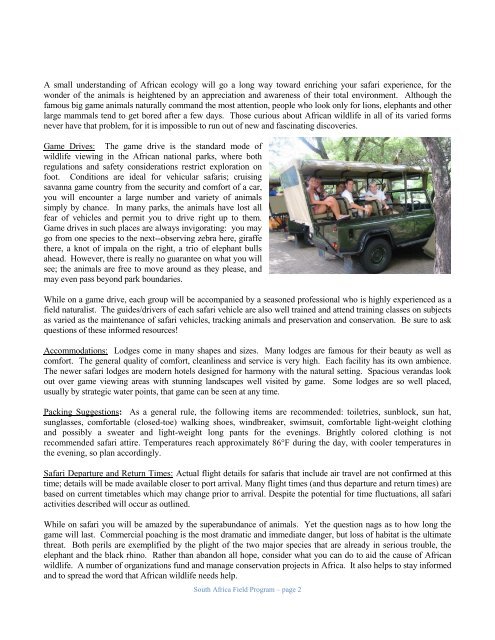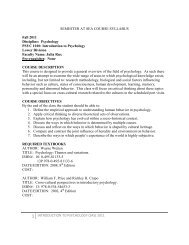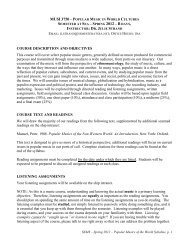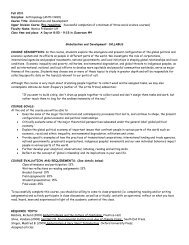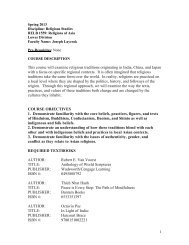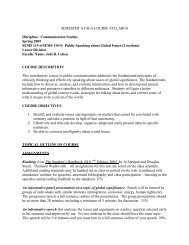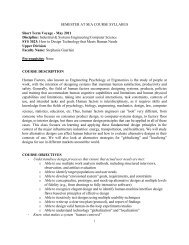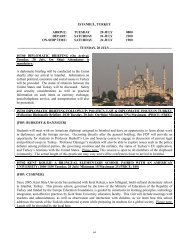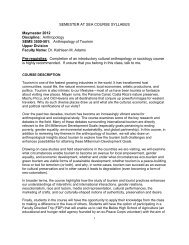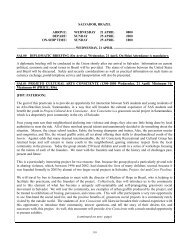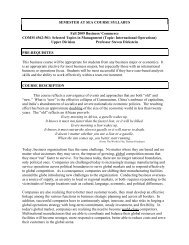Final Field Program - University of Virginia
Final Field Program - University of Virginia
Final Field Program - University of Virginia
Create successful ePaper yourself
Turn your PDF publications into a flip-book with our unique Google optimized e-Paper software.
A small understanding <strong>of</strong> African ecology will go a long way toward enriching your safari experience, for the<br />
wonder <strong>of</strong> the animals is heightened by an appreciation and awareness <strong>of</strong> their total environment. Although the<br />
famous big game animals naturally command the most attention, people who look only for lions, elephants and other<br />
large mammals tend to get bored after a few days. Those curious about African wildlife in all <strong>of</strong> its varied forms<br />
never have that problem, for it is impossible to run out <strong>of</strong> new and fascinating discoveries.<br />
Game Drives: The game drive is the standard mode <strong>of</strong><br />
wildlife viewing in the African national parks, where both<br />
regulations and safety considerations restrict exploration on<br />
foot. Conditions are ideal for vehicular safaris; cruising<br />
savanna game country from the security and comfort <strong>of</strong> a car,<br />
you will encounter a large number and variety <strong>of</strong> animals<br />
simply by chance. In many parks, the animals have lost all<br />
fear <strong>of</strong> vehicles and permit you to drive right up to them.<br />
Game drives in such places are always invigorating: you may<br />
go from one species to the next--observing zebra here, giraffe<br />
there, a knot <strong>of</strong> impala on the right, a trio <strong>of</strong> elephant bulls<br />
ahead. However, there is really no guarantee on what you will<br />
see; the animals are free to move around as they please, and<br />
may even pass beyond park boundaries.<br />
While on a game drive, each group will be accompanied by a seasoned pr<strong>of</strong>essional who is highly experienced as a<br />
field naturalist. The guides/drivers <strong>of</strong> each safari vehicle are also well trained and attend training classes on subjects<br />
as varied as the maintenance <strong>of</strong> safari vehicles, tracking animals and preservation and conservation. Be sure to ask<br />
questions <strong>of</strong> these informed resources!<br />
Accommodations: Lodges come in many shapes and sizes. Many lodges are famous for their beauty as well as<br />
comfort. The general quality <strong>of</strong> comfort, cleanliness and service is very high. Each facility has its own ambience.<br />
The newer safari lodges are modern hotels designed for harmony with the natural setting. Spacious verandas look<br />
out over game viewing areas with stunning landscapes well visited by game. Some lodges are so well placed,<br />
usually by strategic water points, that game can be seen at any time.<br />
Packing Suggestions: As a general rule, the following items are recommended: toiletries, sunblock, sun hat,<br />
sunglasses, comfortable (closed-toe) walking shoes, windbreaker, swimsuit, comfortable light-weight clothing<br />
and possibly a sweater and light-weight long pants for the evenings. Brightly colored clothing is not<br />
recommended safari attire. Temperatures reach approximately 86°F during the day, with cooler temperatures in<br />
the evening, so plan accordingly.<br />
Safari Departure and Return Times: Actual flight details for safaris that include air travel are not confirmed at this<br />
time; details will be made available closer to port arrival. Many flight times (and thus departure and return times) are<br />
based on current timetables which may change prior to arrival. Despite the potential for time fluctuations, all safari<br />
activities described will occur as outlined.<br />
While on safari you will be amazed by the superabundance <strong>of</strong> animals. Yet the question nags as to how long the<br />
game will last. Commercial poaching is the most dramatic and immediate danger, but loss <strong>of</strong> habitat is the ultimate<br />
threat. Both perils are exemplified by the plight <strong>of</strong> the two major species that are already in serious trouble, the<br />
elephant and the black rhino. Rather than abandon all hope, consider what you can do to aid the cause <strong>of</strong> African<br />
wildlife. A number <strong>of</strong> organizations fund and manage conservation projects in Africa. It also helps to stay informed<br />
and to spread the word that African wildlife needs help.<br />
South Africa <strong>Field</strong> <strong>Program</strong> – page 2


